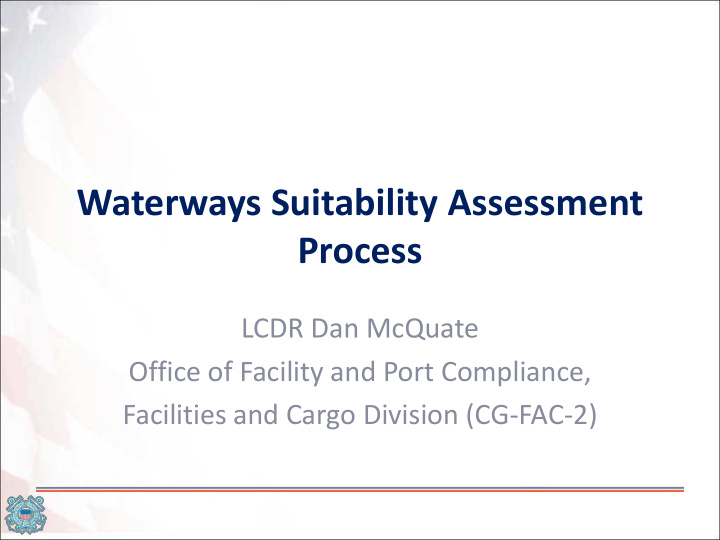



Waterways Suitability Assessment Process LCDR Dan McQuate Office of Facility and Port Compliance, Facilities and Cargo Division (CG-FAC-2)
References • 33 CFR 127 • NFPA 59A • NVIC 01-2011 • Sandia National Laboratory reports • MSM Vol. II
Letter of Intent and Waterways Suitability Assessment in general • Required from owner or operator under 33 CFR 127.007 when: – Intending to build a new facility – Planning new construction to expand or modify marine terminal operations at an existing facility • Applies to both LNG and LHG • LOI: File no later than the date of pre-filing request with permitting agency (Federal, State, or local) – In all instances: at least 1 year prior to the start of construction
WSA Timelines • Preliminary WSA submitted before entering pre- filing with FERC – If not FERC jurisdictional, due when submitting LOI • Follow-on WSA due when submitting application to FERC – If not FERC jurisdictional, due at least 180 days before transferring LNG or LHG • Facility owner/operator must annually review the WSA until operations begin • Submit a final report to COTP at least 30 and no more than 60 days prior to start of operations
NVIC 01-2011 • Guidance Related to Waterfront Liquefied Natural Gas (LNG) Facilities – Intended for FERC jurisdictional facilities – Can be used as a guide by COTP’s for any facility regulated under 33 CFR 127
Preliminary WSA • Often shorter than 10 pages long • Applicants provide an outline to the COTP of what they plan to cover in Follow-on WSA • Brief discussion on: – Port characterization – Characterization of LNG Facility and LNG Tanker Route – Risk Assessments for Maritime Safety and Security – Risk Management Strategies – Resource Needs for Maritime Safety, Security, and Response – Risk Mitigation Measures and Conclusions • Allows COTP to ensure applicant ID’d all pertinent port stakeholders
Follow-on WSA • Complete analysis of topics covered in Preliminary WSA • Identify: – Credible security threats – Navigational safety hazards for LNG and LHG marine traffic – Appropriate risk management strategies – Resources needed to carry out risk management strategies • Will include “Sandia Zones” • Additional resources needed when the facility goes into operation should be identified and provided by the applicant, not the Coast Guard or other agencies
WSA Wrap Up • The amount of effort necessary for a WSA can vary by the facility. – Factors include location, current vessel traffic, local politics, etc. • The vast majority of the work on the WSA is completed by the project proponent • COTP/COTP staff engagement early in the process makes next steps easier
Letter of Recommendation • Coast Guard’s recommendation to the jurisdictional agency as to the suitability of the waterway for LNG or LHG marine traffic • Assess the current state of the waterway • Does not determine which waterway user should have usage rights • If there is no jurisdictional agency, no LOR is issued – COTP retains authority to ensure the maritime safety and security of the waterway
Letter of Recommendation • 33 CFR 127.009 outlines regulatory requirements • Recommendation based on: – WSA; – Density and character of marine traffic in the waterway; – Locks, bridges, or other man-made obstructions in the waterway; – Factors adjacent to the facility – water depths, tidal range, protection from high seas, natural hazards, underwater pipelines and cables, and distance of berthed vessel from the channel; and – Any other issues affecting the safety and security of the waterway and considered relevant by the COTP
Review and Validation of WSA • COTP reviews and validates WSA – Checklist in Enclosure 4 of NVIC 01-2011 – Work with Local and State Governments, key stakeholders (AMSC, Harbor Safety Committee, etc.), public, and others as ID’d by the COTP • Protect SSI and commercially proprietary information
Review and Validation of WSA • Review: examine the WSA to determine if it includes all information necessary to assess the suitability of the waterway for LNG marine traffic. • Validate: “reality check” of follow-on WSA to determine if it presents a realistic and credible analysis of the public safety and security implications of LNG traffic
COTP Response • COTP drafts LOR and LOR Analysis – Must not impose requirements or mandate conditions – Receive feedback from State before issuing LOR and LORA • Sample of LOR and LORA included in NVIC 01- 2011
Contents of LOR Analysis • Assumptions made • Description of port • Summary of methods used to review WSA • ID stakeholders that participated • Whether waterway is suitable or not – Example verbiage in Enclosure 6 of NVIC
Letter of Recommendation Analysis • This document is Sensitive Security Information (SSI) • Outlines the information and decision-making rationale used by the COTP in assessing the suitability of the waterway • Looks at territorial sea boundary to the facility
Other LOR Notes • Issuance does not constitute agency action – NEPA not necessary • The owner or operator, or government in the jurisdiction of the facility may request reconsideration of the LOR • Other persons may comment by submitting comments and relevant information to the agency having jurisdiction for the project
Questions?
Recommend
More recommend